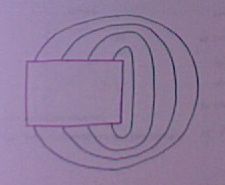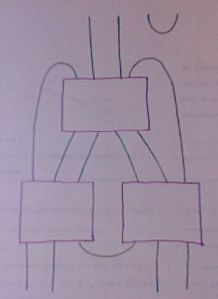Last week I talked about the Temperley-Lieb algebra – the algebra of boxes with n top points connected in a non-crossing way to n bottom points, with multiplication as stacking boxes. Some of you may have noticed (but weren’t picky enough to point out) that I didn’t specify whether AB meant A on top of B, or B on top of A. Of course, it doesn’t really matter, but we should pick one, right?
But wait … why are these two stackings the only candidates for multiplication? Why shouldn’t we multiply by connecting the right side of a box to the left side of the next box?

or by connecting some top points and some bottom points of each box?
The observation that there are lots of different multiplications on Temperley-Lieb might lead you to wonder about other operators on Temperley-Lieb. For instance, we can map to
by connecting any point of the first box to a point of the second, and the rest of the points to the boundary:
Everything I’ve drawn above is an example of a “planar tangle” – and the trace we used last week is also a planar tangle, which takes to
:
In general, a planar tangle is a diagram where the strings of k input boxes and an output box are connected among themselves in non-crossing ways. Here’s another example – which is a fine planar tangle, although it’s not clear that it should have any particular meaning if we let it act on Temperley-Lieb inputs.
Planar tangles can sometimes be composed with each other: we can connect the output of one tangle to the input of another tangle, if both have the same number of strings. Here’s an unnecessarily complicated example:
Notice that in the LHS, we have labels 1, 2 and 3 in the boxes — this is just so we know what order to do the compositions in. In the MHS, we’ve stuck the tangles in the boxes they go into; and on the RHS, we’ve discarded the information of the old boundaries and isotoped the strings to make a nicer picture.
The set of planar tangles, with the operation of composition, is an operad. (I’m not going to tell you what an operad is in general, but if you’re curious http://homepages.ulb.ac.be/~fschlenk/Maths/What/operad.pdf is a nice introduction.) A planar algebra is, basically, a representation of the planar operad: a family of vector spaces with an action by planar tangles which is compatible with composition.
Temperley-Lieb is not just the simplest and most natural example of a planar algebra; it’s also one of the most important ones. Coming soon: Some other examples!






This subject reminds me of my days as a digital logician, specifically, the “carry-look ahead” structure of fast adders. I should write a post on the subject. Until then, here’s the wikipedia article on carry look ahead, and here’s the data sheet for the old 7400 series TTL part, and here’s a data sheet (see page 5 for the recursive diagram showing how to use them).
Thanks, Carl, that’s a cool connection you’ve made. Jones claims that part of the power of planar algebras is that they let you do calculations in the plane, so to speak, instead of on a line, and this is a great example of that.
And my previous post reminds me that I’ve failed to give credit, in the above post, to Vaughan Jones for his invention of planar algebras. Without which, subfactorists would still be doing calculations like .
.
Hey Emily,
I’m still having trouble understanding the connection between the planar picture and the bimodule picture Noah has been talking about. Does it have something to do with those times Vaughan shaded in various regions between the spaghetti?
Yes, Scott, I’ll post on that Sunday or Monday.